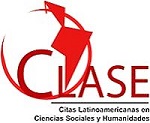Environmental Indicators - A successful case of sustainability in the freight sector Valle de Aburrá - Colombia.
Keywords:
Good environmental practices, clean production, environmental indicators, mobile sources, transportation of freightAbstract
In the current Colombian National Policy for Cleaner Production and Sustainable Consumption, there are several Programs that have been articulated in different productive sectors, one of these has focused on the Freight Since 2008. A participative action research project was led by the Metropolitan Area of the Aburrá Valley (AMVA), as the local urban environmental authority, was executed by Research Groups from universities in the region. The objective was to encourage the adoption of Best Practices for Driving and make possible environmental and economic benefits, which are evidenced by presenting a model of a successful case within a group of 118 companies in the sector, in order to implement environmental indicators. This way, a projection of reaching better conditions of sustainability and reduction of the carbon footprint of an activity that generates high environmental pressure can be carried out.
Article Metrics
Abstract: 1072 PDF (Español (España)): 879References
AHSAN, Alam. M. H. (2014). Reducing transit bus emissions: Alternative fuels or traffic operations. Atmospheric Environment, 128-39.
ALZATE, Juan Manuel. (Enero- junio de 2007). Modelos para analizar el desarrollo del transporte urbano del Valle de Aburrá con consideraciones económicas, energéticas y ambientales. Revista de Ingeniería (25), Bogotá. Universidad de los Andes. 114-121.
ÁREA METROPOLITANA DEL VALLE DE ABURRÁ. AMVA. (2008). Guía para el manejo integral de Residuos, subsector de transporte de carga. Medellín.
ÁREA METROPOLITANA DEL VALLE DE ABURRÁ. AMVA. (s.f.) La movilidad en la región metropolitana. Recuperado el 11 de abril de 2014 de http://www.areadigital.gov.co/ Movilidad/Pages/Inicio.aspx
ÁREA METROPOLITANA DEL VALLE DE ABURRÁ. AMVA. Consultoría 455. (2011). Informe final de seguimiento a los planes de acción de producción más limpia y opacidad. Medellín.
ÁREA METROPOLITANA DEL VALLE DE ABURRÁ. AMVA, UPB. (2011). Inventario de emisiones atmosféricas del Valle de Aburrá. Medellín.
ÁREA METROPOLITANA DEL VALLE DE ABURRÁ. (2010). Lineamientos Técnicos para el Plan de Descontaminación del Aire en la Región Metropolitana del Valle de de Aburrá. Medellín.
ÁREA METROPOLITANA VALLE DE ABURRÁ Y ALCALDÍA DE MEDELLÍN, Secretaría del Medio Ambiente. (2006). Manual de Gestión Ambiental Transporte de carga. Medellín.
CHEUNG, C. ZHU, Ruijun. (2009). Regulated and unregulated emissions from a diesel engine fueled with biodiesel and biodiesel blended with methanol. Atmospheric Environment, N°45. 4865-4872.
CRAFT, Elena& NORSWORTHY, Marcelo. (July de 2013). Emissions reduction analysis of voluntary clean truck programs at US ports. TRANSPORTATION RESEARCH PART D: Transport and Enviroment, 23-27.
DOMÉNECH, Juan Luis. (21 de marzo de 2011). La huella de carbono concepto, utilidad y aplicación. Obtenido de http://www.fundaciongasnaturalfenosa.org/SITECOLLECTIONDOCUMENTS/ACTIVIDADES/SEMINARIOS/ZARAGOZA%202011%2003%2021/1._JUAN_LUIS_DOMENECH.PDF
FIKSEL, Joseph, EASON, Tarsha, & FREDERICKSON, Herbert. (octubre de 2012). EnvironmentalProtection Agency, EPA. Obtenido de A Framework for Sustainability Indicatorsat EPA.: http://www.epa.gov/sustainability/docs/framework-for-sustainability-
indicators-at-epa.pdf
GÓMEZ, Miryam. (2010). Evaluación del impacto en la concentración PM2.5 a partir del mejoramiento del combustible en la calidad del aire del Valle de Aburrá. Medellín: Libro Arte Medellín.
JIMING, Haoa, S. Z. (2014). Historic and future trends of vehicle emissions in Beijing, 1998–2020: A policy assessment for the most stringent vehicle emission control program in China. Atmospheric Environment, Vol 89. 216-229.
COLOMBIA. MINISTERIO DEL MEDIO AMBIENTE (2010). Política Nacional de Producción más Limpia, obtenido de http://www.minambiente.gov.co/documentos/normativa/ambiente/politica/polit_produccion_mas_limpia.pdf
RIS, Charles. (2007). US EPA health assessment for diesel engine exhaust: a review. Inhal. Toxicol, 229-239.
TDM TRANSPORTES S.A.S. (Febrero de 2014). TDM Sostenible. Recuperado en mayo de 2014 de http://www.tdm.com.co/tdmsostenible.html
UNITED NATIONS ENVIRONMENT PROGRAMME. (2006). UNEP Launches Campaign to plant a billion trees. Nairobi: ONU.





















